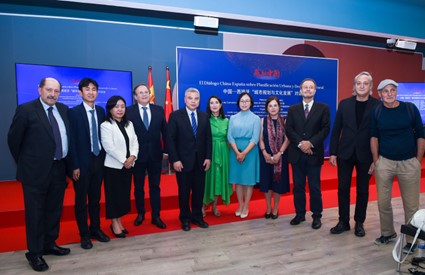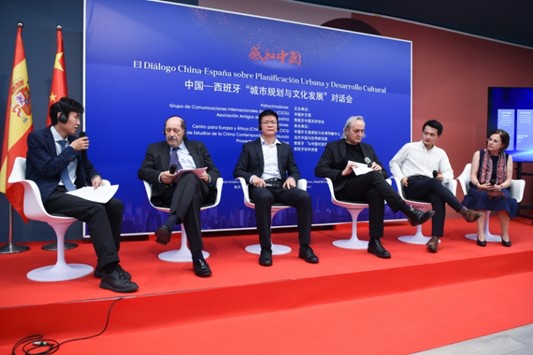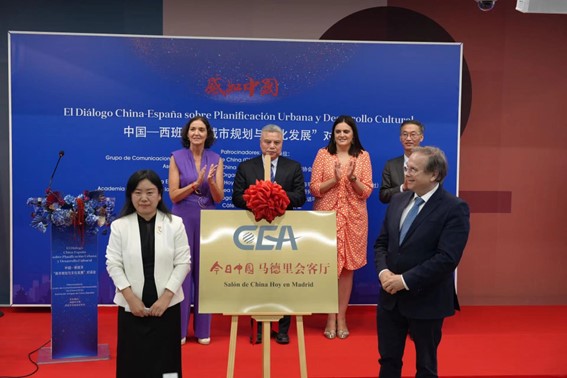The China-Spain Dialogue on Urban Planning and Cultural Development opened at the Circulo de Bellas Artes of Madrid, Spain, on June 28, attended by dignitaries including Hu Kaihong, Chinese vice minister of the Central Office for Cultural and Ethical Progress, Yao Jing, Chinese ambassador to Spain, María Reyes Maroto Illera, councilor and spokesperson of the Municipal Socialist Group of the Madrid City Council and former industry, trade and tourism minister of Spain, and Natalia Ucero Pérez, senator and first secretary of the presidium of the Foreign Affairs Committee of the Senate of Spain.

The China-Spain Dialogue on Urban Planning and Cultural Development is held in Madrid on June 28, 2024.
The dialogue was sponsored by the China International Communications Group (CICG) and Spain’s Friends of China Association. It was organized by the CICG Center for Europe and Africa (China Today) and the Academy of Contemporary China and World Studies, and supported by the Dialogue with China Project of Spain and Cátedra China.
The participants agreed that the event’s theme “urban planning and cultural development” was highly relevant to the advancement of urban civilization. Urban planning provides the space and platform needed for the development of urban civilization, while culture is the soul of a city and where its appeal comes from. China and Western countries have similar views on people-centered urban planning that emphasizes respect for nature, cultural heritage and green development though they have varied experiences and practices.
The dialogue reached consensus on passing on cultural heritage to protect the cultural and historical value of cities; encouraging cultural innovation to boost cities’ future development; and boosting cultural exchanges to open a new chapter in mutual learning between civilizations.
Liu Shilin, director of the Institute of Urban Science in Shanghai Jiao Tong University, spoke on the urban renewal program of Shanghai centered on its two major rivers and the city’s efforts to revive its cultural heritage. He elaborated on Shanghai’s success in transforming the “rust belts” along the Suzhou and Huangpu rivers into scenic residential areas and dynamic innovation incubators. Shanghai has set an example for other Chinese cities seeking urban renewal and cultural inheritance. It also offers inspiration for other countries in urban revitalization through cultural programs and urban development through innovation.
Liu said to achieve sustainable development, cities should transform from a space for production to a space for living, and shift their focus from pragmatic functions to cultural functions. When Shanghai hosted the World Expo 2010, it chose the theme “Better City, Better Life.” Echoing this goal, the regions along the Suzhou and Huangpu are being renovated to restore the waterfront views for the enjoyment of the local people.

Participants in the discussion session of the China-Spain Dialogue on Urban Planning and Cultural Development in Madrid on June 28.
Zhang Yingle, lecturer at the School of Architecture of Southeast University and guest lecturer at Technische Universität Berlin, spoke of the renewal of the historical districts and streets in Chinese cities from the perspective of cultural development. He said the approach of China’s urban renewal has shifted from preserving entire streets or districts to preserving their values and upgrading their functions. Ancient streets and districts are no longer regarded as isolated antique places but are integrated into the development of modern cities, lifestyles and industries.
Zhang gave the examples of the ancient city of Nantou in Shenzhen, the Xiaoxihu region in Nanjing, and the Laocaichang area in Xi’an to share China’s experiences in carrying forward its cultural heritage in the renovation of historical urban streets and districts. Through spatial reshaping, these projects have not only preserved the cultural and spatial memory of local residents, but also injected new life into these areas by promoting diversified cultural and economic development of the cities where they are located.
María Rosa Cervera Sardá, a well-known Spanish architect and president of Cátedra China, gave a speech centered on how to organically integrate urban planning with ecological conservation and the efforts in carbon emission reduction so as to create a high-quality living space for urbanites. She said Chinese civilization values harmonious coexistence between man and nature since ancient times, which is particularly instructive today. Cervera said urban planning should incorporate more natural environment designs, including forest parks, urban green corridors and orchards. At the same time, existing building roofs and facades can also be used to grow green plants, which will not only beautify the environment but also absorb carbon dioxide from the air. In addition, urban construction should take into consideration reducing carbon emissions with energy-saving designs and energy-saving materials. Architectural designs can draw inspiration from the natural environment, such as the structures of some animals and plants like shells and flowers. In her eyes, this kind of architectural design concept based on nature is sustainable and is leading a new international trend.
Juan Albert, a Spanish architectural designer and professor at the Gengdan Institute of Beijing University of Technology, spoke on how to embody and promote sustainable development of the natural environment in urban design based on his experience in various countries. He emphasized that architectural design should break away from the prevailing way of thinking that has caused many environmental problems, and be creative and imaginative while cherishing fine traditions. He listed specific cases in China and Spain to accentuate the attempts of the two countries to promote harmonious coexistence of man and nature in urban planning, as well as to solve problems such as creating urban public space in urban planning.
Cities are the receptacles of culture, and culture is the soul of every city. Many cities with long histories have two sides. One is the old city, with many historical and cultural areas which need protection and inheritance; the other is the new city, the city of the future, which people hope to upgrade and transform. Only when both are accomplished can culture be inherited and innovated for real development. Therefore, in the process of urban planning, construction, renewal and upgrading, the issue is how to deal with the relationship between the old and the new city, the historical city and the city of the future; how to deal with the relationship between culture, production and life, and how to create an urban space that not only inherits history and culture, but also encourages economic and social innovation.
During the discussion session, urban planners and architectural designers from China and Spain exchanged ideas. Angel Zarabozo, vice president of the Madrid World Capital of Construction (MWCC), Zhao Jie, vice director of the Nanjing Municipal Office of Cultural and Ethical Progress, José Luis Esteban Penelas, chair of architecture at European University of Madrid, Zhang Yingle, lecturer at the School of Architecture of Southeast University, Maria José Masnou, member of UNESCO Chair in Intermediate Cities, shared classic cases from China and Spain and their own concepts.

China Today Salon in Madrid is formally launched at the China-Spain Dialogue on Urban Planning and Cultural Development in Madrid on June 28.
Zhao Lijun, President of the CICG Center for Europe and Africa (China Today), and Antonio Miguel Carmona, President of Spain’s Friends of China Association, jointly launched the China Today Salon in Madrid, established in collaboration between the two organizations. The China Today Salon will provide a new platform for cooperation between China and Spain in various fields, including economy and trade, culture, media, and think tanks, Zhao pointed out. It will also become a window for the Spanish and European people to understand Chinese culture, according to Zhao. “We will promote exchanges and mutual learning between China and Spain, as well as between China and Europe through forums and exchange activities in areas across the board,” Zhao said.
Carmona said in Europe, people’s understanding of China is still far from enough, and they do not know what the real China looks like. “The establishment of the China Today Salon in Madrid will promote exchanges between China and Spain, and between China and Europe, helping various communities in Spain to understand China more comprehensively,” he said.
The Academy of Contemporary China and World Studies launched a research project on urban civilization exchange and mutual learning during the dialogue. Yuan Lin, director of the Office for Major Projects under the Academy of Contemporary China and World Studies, said the aim of the project is to build a platform for dialogue on urban research between China and foreign countries, encourage city governors, planners, and researchers from different countries to propose research topics, and organize experts to carry out joint research. The project will study the common issues in urban governance and cultural inheritance faced by countries and propose strategies and suggestions on how to better carry out dialogues and exchanges, thus achieving mutual learning and cooperation to address common urban challenges.